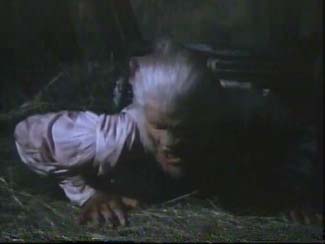
|
It Came from the Basement:By John SealFebruary 20, 2003
The story: A boy is raised in the wilderness by wolves. He is reintroduced into human society, with tragic results. The film: Legend of the Werewolf looks like a late period Hammer production, which in many respects it is. Such Hammer luminaries as Peter Cushing, Freddie Francis, Michael Ripper, and "John Elder" all had a hand in this Tyburn production shot in what appears to be a very small part of Pinewood Studios. Set primarily in "Paris," that great city is here represented by a paltry city block, which seems to include the local café, house of ill repute, mortuary, and zoo. The characters, cut straight out of the Hammer play-book, wander back and forth between buildings until the film settles on a climax set in the sewers - which presumably run beneath the same city block. Those looking for a bold re-interpretation of the werewolf mythos need to look elsewhere. This film revels in its lack of originality, saving its one tiny morsel of invention for the very end: silver bullets cannot be touched by human hands! The werewolf himself appears after desperately shoddy transformation effects courtesy of Charles Staffell, and until the final reel, is represented by red-tinted point of view shots and close-ups of bloodshot eyes and bloody teeth. His full face is unveiled in the climactic pursuit through the sewers, and makeup artists Jimmy Evans and Graham Freeborn clearly copied the design work done by Roy Ashton for 1961's far superior Curse of the Werewolf. There are also hints of religious persecution - no doubt anti-Semitism - early in the film that echo those in Curse. The film has a few moments of gleeful gruesomeness - none better than when Peter Cushing holds aloft a piece of viscera and declaims, "oh dear, that's very nasty" - but is very tame compared to comparable product being made on the Continent during the same period. Fans of Hammer's penchant for buxom young women will be pleased but frustrated at the numerous tight corsets that stay firmly in place. The cast and crew: The always wonderful Peter Cushing is top-billed but doesn't appear until the 30-minute mark. Cushing nonetheless goes on to (unsurprisingly) dominate the film with his usual mix of steely determination and gentle humor. He is, in fact, introduced in a scene surely intended to remind the audience of his frequent appearances as Dr. Frankenstein: Cushing is seen at the local abattoir performing an autopsy. There's also a substantial role for cheeky chap Ron Moody as the local zookeeper, with Moody emphasizing the comic whilst also reminding this viewer of his more sinister appearance as Fagin in 1968's Oliver!. There's a small role for Hugh Griffith as the owner of a traveling circus at the start of the film, and it's unfortunate that the story couldn't do more with this character as Griffith is excellent. The werewolf is played by David Rintoul, who somehow learns to converse with a very, very proper English accent sometime between tearing baby bunnies apart as a child and being hired by Ron Moody to care for his decrepit and zoo-bound wolfhounds. Rintoul is best known to American viewers as Dr. Clive in the recent television series Horatio Hornblower (2001 GB). Roy Castle appears briefly as a photographer in a feeble attempt at historical humor: Cushing addresses him as 'M'sieur Daguerre'! The only other cast member of note is good old Michael Ripper, on screen for no more than two minutes as one of the monster's victims. In an interesting but surely unintentional shot immediately after his murder, Ripper's corpse floats to the surface of the sewer, assuming a decidedly Christ-like attitude. Bizarrely, this is then followed by a scene in the mortuary, where Cushing discovers that one of the werewolf's victims - previously thought dead - is still alive! Unfortunately for film analysts worldwide, it's not Ripper resurrected on the slab, but an uncredited (and mustache free) actor. Legend of the Werewolf was directed by the reliable Freddie Francis, most recently the lenser of David Lynch's excellent The Straight Story. Francis knew he was dealing with very little in the props department and keeps the camera tightly focused on his characters. Screenwriter "John Elder" was, of course, Hammer main man Anthony Hinds, who had made his screenwriting debut with - surprise, surprise! - Curse of the Werewolf, elements of which appear throughout this inferior film. Nostalgia value: This film will provide satisfaction for fans who aren't picky about their '70s British horror frock flicks. There are a few 1970s hair faux pas on display, mostly atop extras, but also on the face of actor David Bailie, who wears one of those fu manchus that all good swingers wore at the time. The print: Acceptable but dull, Legend of the Werewolf only looks bad when it reverts to its tinted sequences. The film also appears to have been shot full-frame or very close to it, as there's zero evidence of pan and scanning. The obvious budget limitations exemplified by the meager props and sets would have looked particularly threadbare in any kind of wide-screen process. DVD prognosis: This seems like an obvious choice for Image's periodic "Euroshock" collection, a series that doesn't shy away from some rather tame and unshocking films. Failing that, perhaps a bargain company like Alpha (who released a competent DVD of 1973's Theatre of Blood) or Brentwood might oblige.
Ratings: Film: C. Without Cushing, a C-. Print: B-. The Interglobal transfer is fine, but I haven't been able to compare it to the Moore Videos release. DVD Worthiness: C-. I can't give anything with Cushing a failing grade, but this is weak tea indeed, and needs to take a number well to the back of the line. View other columns by John Seal |
Thursday, October 31, 2024
© 2006 Box Office Prophets, a division of One Of Us, Inc.